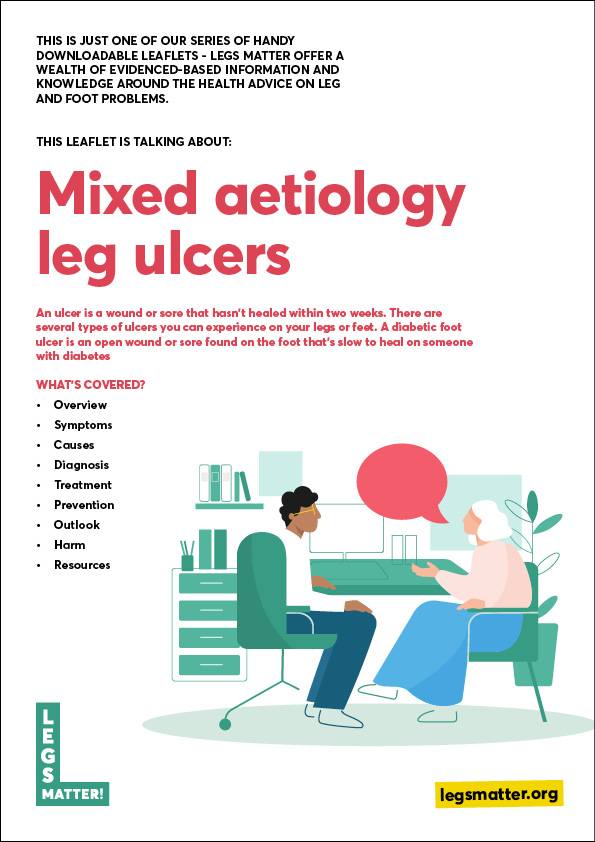Overview – what is a mixed aetiology leg ulcer?
A mixed aetiology leg ulcer is a wound on the lower leg which is caused by a combination of both venous and arterial disease. It’s important to acknowledge that the level of arterial insufficiency can vary depending on the individual.
Symptoms – what are the key symptoms of mixed aetiology leg ulcers?
You may experience a range of symptoms which are indicative of both venous and arterial disease. Details of these symptoms can be found on the venous leg ulcers and arterial leg ulcers pages.
The symptoms of venous disease are likely to be more obvious, whereas the symptoms of arterial disease less so, and may only be uncovered during the assessment process by your healthcare professional.
What causes mixed aetiology leg ulcers?
Mixed aetiology leg ulcers are caused by a combination of venous and arterial disease.
A venous leg ulcer (VLU) is a break in the skin, between the knee and ankle joint, and is caused by damage to the vein(s) in the lower leg, which become weaker. The weakened vein walls prevent the valves in the veins from closing sufficiently. If the valves cannot close properly, some of the venous blood backflows when the heart beats and the pressure inside the vein increases, pushing small components of the venous blood across the vein wall into the surrounding flesh and skin. This damages the flesh and breaks the skin. Because the vein is weak and leaking, the skin cannot heal.
We have deep veins (inside the leg muscles) and superficial veins (outside the leg muscles) and small veins (perforators) connecting them together. Either or both may be damaged.
Veins can become damaged due to a number of reasons, including:
- An injury
- Previous fracture of the bones in the leg, ankle or foot
- Previous operations
- A clot (DVT)
- Increased abdominal weight (pregnancies or obesity)
- Because the veins get weaker as we get older
Arterial leg ulceration stems from a condition known as peripheral arterial disease (PAD).
It is caused by a build up of fatty deposits inside the arteries of the leg. Over time these deposits make the arteries narrower and result in a restriction of the blood flow to the leg. This is also called atherosclerosis.
Risk factors include:
- Smoking
- High blood pressure
- Diabetes
- High cholesterol
Diagnosis – getting diagnosed with a mixed aetiology leg ulcer
It is important to see your GP / Practice Nurse / District Nurse as soon as possible after your wound or symptoms appear to get an assessment, diagnosis and have the appropriate treatment / intervention/s.
General Assessment
Your assessment should include questions about:
- Your general health
- Your current and past medical history
- The appearance, shape and feel of your lower leg and your ulcer
- Pain assessment to include factors that aggravate and relieve symptoms
- Numbness or weakness in your leg
Skin Assessment
Your healthcare provider will look for:
- Wound shape, size, depth and the type of tissue in the wound bed, length of time wound has been present and progress of wound
- Ulcer location: what part of the leg is the ulcer on
- Oedema or swelling; how far up the leg does it go? does it go when you elevate your leg?
- Varicose veins
- Inflammation and wound or skin infection
- Eczema / contact dermatitis
- Changes to the shape of your leg
- Temperature of the skin on your leg, foot and toes
- The skin on your leg can look red when hanging down and go paler when lifted up
- Your wound turning black (necrosis) and beginning to smell. Be aware that skin changes may be harder to see on black or brown skin
Tests
Your healthcare provider should:
- Listen to the pulses in your foot using a hand held ultrasound scanner
- Test the blood pressure in your arms and legs and compare them together. This is a test of the strength of the arteries in your lower leg and foot. This is often called a ‘Doppler’ Test.
- Some people may need to have additional tests depending on the results.
- Sometimes you may need a blood test
Treatment – how to treat mixed aetiology ulcers
It is important to see your GP / Practice Nurse / District Nurse as soon as possible to get an assessment, diagnosis and have appropriate intervention. For mixed aetiology leg ulcers, this may include using a safe level of compression and/ or onwards referral to vascular services.
Things to say when booking your appointment:
- If your wound is hot or red, this may be urgent and require care immediately
- How the wounding happened or whether it just spontaneously started
- Make it clear if you have diabetes
- Make it clear if the wound has not healed within two weeks and it’s worrying you
- Let them know if it smells or if it’s painful and what makes this better or worse
Language used
You may hear different words to describe your wound such as ulcer, leg ulcer, sore, laceration, chronic wound and maybe others. Ask your nurse to explain their choice of word and what this may mean for you.
If you’re struggling to get an appointment with your GP, there might be a Leg Club or specialist leg clinic in your area. You may be able to attend these without having to be referred by your GP.
Compression
Compression may be used if deemed safe, this will depend on your individual assessment outcomes. More details on compression can be found on the venous leg ulcer page.
Surgery
Options may be available for mixed aetiology leg ulcers.
Venous surgery
This may include removing the damaged vein which can improve healing and also reduce the risk of venous ulcers coming back. Surgery can include:
- Removing the varicosed vein
- Applying heat, ultrasound or foam to seal the damaged vein
Your Vascular Surgeon will discuss with you which is the best option for you once you have had your veins scanned to see which one is damaged.
Arterial surgery
This may include procedures to improve the blood supply to your lower limb. Your Vascular Surgeon will discuss with you which is the best option for you once you have had your arteries scanned to see which one is damaged.
Dressings
There are many different dressings available and the choice depends on the condition of your wound, which will change as you heal. You may need a few different dressings over the course of your treatment.
Prevention – how to prevent mixed aetiology leg ulcers occurring or reoccuring
Mixed aetiology leg ulcers can recur if the damaged vein is not supported or removed. Therefore, if wearing compression was part of your treatment to heal the ulcer, it should continue to be worn even when the ulcer has healed to stop it coming back.
Leg elevation (ankle above hip level) is important to reduce the pressure inside the veins and will help stop the vein leaking but as soon as you lower your leg or walk the vein will start leaking again unless you are wearing a compression garment.
It is also important to know that when the foot and ankle move, this helps squeeze the muscles around the veins and this reduces the effects of the high pressure in them. Exercise is proven to be a significant factor in reducing the severity in symptoms of peripheral arterial disease (PAD). It is also good for improving your mood and self-esteem.
Mixed aetiology leg ulcers can recur if you are a smoker, an important change that can be made is to stop smoking. If you continue to smoke your symptoms of arterial disease will undoubtedly progress.
Outlook – healing mixed aetiology leg ulcers
The outlook of a mixed aetiology can be different for each individual depending on the severity of the arterial disease component. However, with treatment for arterial disease and life style changes, alongside treating the underlying venous disease, mixed aetiology leg ulcers should improve.
If your assessment shows you’re safe to have compression, this will support the veins and stop them leaking and allow the body to heal the wound. Continuing to wear your compression when your mixed aetiology leg ulcer has healed can help reduce the risk of the wound coming back.
How can I help my mixed aetiology leg ulcer heal?
- Make an appointment to see your GP / Practice Nurse or District Nurse as soon as possible to be assessed, get a diagnosis and access treatment that will heal your ulcer
- If you have been given compression garments by your health provider, ensure you wear them
- Elevate your leg with your ankle above your hip level if possible and tolerated – use pillows under the foot of your mattress, while you are lying on a sofa or sitting in a chair with your leg(s) elevated
- Ask to see a Vascular Consultant to have your veins/ arteries scanned and assessed to see which vein/ artery is damaged and if you may benefit from intervention. Do this even if you do not end up choosing to have surgery as the scans can find which vein / artery is causing the problem and guide the way forward for your treatment in the future
Harm – the risk factors
Inaction or insufficient action on mixed aetiology leg ulcers can cause harm. This includes:
- Not checking legs properly or doing basic checks, such as a Doppler test
- Not performing a vascular assessment to determine if suitable for compression
- Not using adequate compression if indicated, can lead to worsening disease
- Not being referred to vascular services for venous intervention if required
If you have any concerns about the treatment or care you are receiving, it is important to speak up.
Resources – for arterial ulcers
EWMA – Lower Leg Ulcer Diagnosis and Principles of Treatment (PDF)
National Wound Care Strategy Programme – Leg Ulcer Recommendations Summary (PDF)
Mixed aetiology leg ulcer downloadable leaflet (PDF)
We’ve created a handy downloadable leaflet of the key information on this page so you can easily print it out for personal reference or to hand to a patient or healthcare professional. Or you can also simply forward it on by email.
Other support
Some organisations you can contact for further information.
Accelerate Based in East London, Accelerate can accept national referrals from your GP / specialist to our world-class centre where we pioneer and trial experimental new treatments for chronic leg ulcers / wounds, lymphoedema and mobility challenges.
Contact details
020 3819 6022
hello@acceleratecic.com
Find out more on the Accelerate website
British Heart Foundation The British Heart Foundation were founded in 1961 by a group of medical professionals wanting to fund extra research into the causes, diagnosis, treatment and prevention of heart and circulatory disease. Today they are the nation's heart charity and the largest independent funder of cardiovascular research.
Contact details
0300 330 3322
supporterservices@bhf.org.uk
Find out more on the British Heart Foundation website
Diabetes UK Diabetes UK are the leading UK charity for people affected by diabetes it’s their responsibility to lead the fight against the growing crisis. And this fight is one that involves all everyone – sharing knowledge and taking diabetes on together.
Contact details
0345 123 2399
helpline@diabetes.org.uk
Find out more on the Diabetes UK website
The Lindsay Leg Club Foundation Promoting and supporting community based treatment, health promotion, education and ongoing care for people who are experiencing leg-related problems - including leg ulcers and other wound care issues.
Contact details
01473 749565
lynn.bullock@legclubfoundation.com
Find out more on the Lindsay Leg Club Foundation website
Tell us what you think
If there’s anything you want to ask us or tell us, whether it’s a suggestion about our website, a complaint, or a compliment, drop us a line at
support@legsmatter.org










